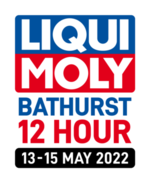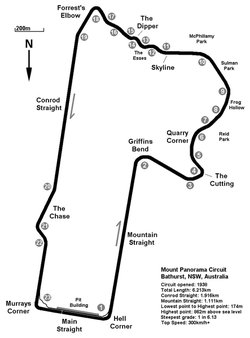Bathurst 12 Hour
 |
|
 |
|
| Venue | Mount Panorama Circuit |
|---|---|
| Corporate sponsor | Liqui Moly |
| First race | 1991 |
| Duration | 12 Hours |
| Most wins (driver) | John Bowe (3) |
| Most wins (manufacturer) | Mazda (4) |
The Bathurst 12 Hour (currently known as the Liqui Moly Bathurst 12 Hour for sponsorship reasons) is an endurance race for GT and production cars held at the Mount Panorama Circuit, in Bathurst, Australia in February each year. The race was first held in 1991 for Series Production cars and moved to Sydney's Eastern Creek Raceway in 1995 before being discontinued. The race was revived in 2007, again for production cars, before adding a new class for GT3 and other GT cars in 2011. This has led to unprecedented domestic and international exposure for the event. In all, sixteen races have taken place; fifteen at Mount Panorama and one at Eastern Creek Raceway.
The event was inspired by the long-running Bathurst 1000 touring car race, which began at the Phillip Island Grand Prix Circuit in Victoria in 1960 (before moving to Bathurst in 1963) as a race for standard production cars with minimal modifications. As the Bathurst 1000 evolved, the touring cars that raced in it moved further and further away from the minimal modifications of the original race. The Bathurst 12 Hour was intended to create the original feel of the Bathurst 1000, while providing a unique test in the longer race distance, rather than replicating the 1000 kilometre event.
In 1990, Vincent Tesoriero, a race promoter and former Bathurst 1000 competitor, looked at the decline of Group A touring cars in Australia and saw an opportunity to run a 12-hour endurance race for Series Production cars at Mount Panorama. Tesoriero secured long time Bathurst 1000 sponsor James Hardie as a sponsor for the event in late 1990, leaving limited time to launch and organise the event for the Easter weekend in 1991. The race regulations were based on the Group 3E Series Production Car rules then in use in the Australian Production Car Championship for naturally aspirated four- and six-cylinder passenger sedans, but also allowed turbocharged and V8-engined cars which had been outlawed from the Production Car Championship in 1990. Despite the short deadline, twenty-four cars were entered for the first race, spread over six different classes based on engine capacity and sporting specification. Exotic mid-engined sports cars and GT cars were not eligible to enter.
...
Wikipedia
